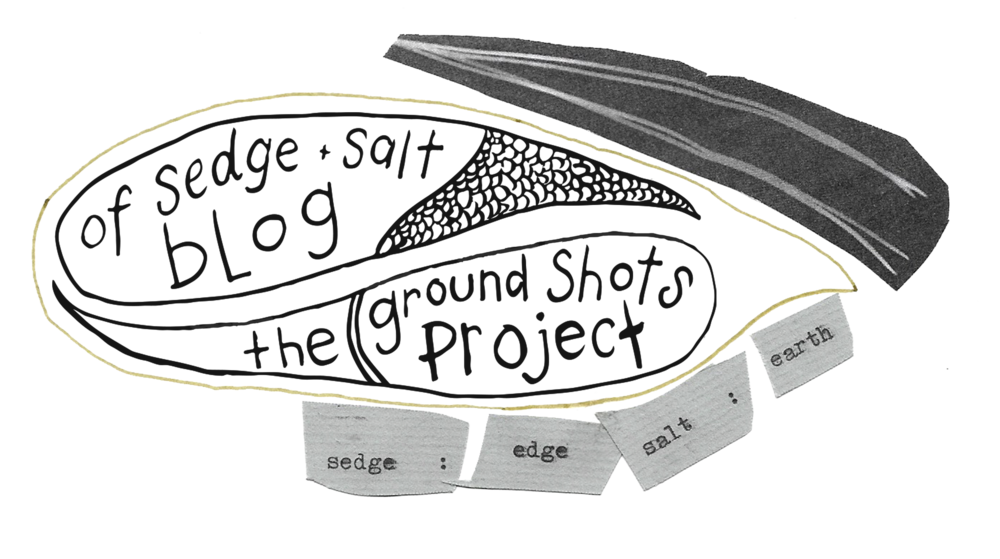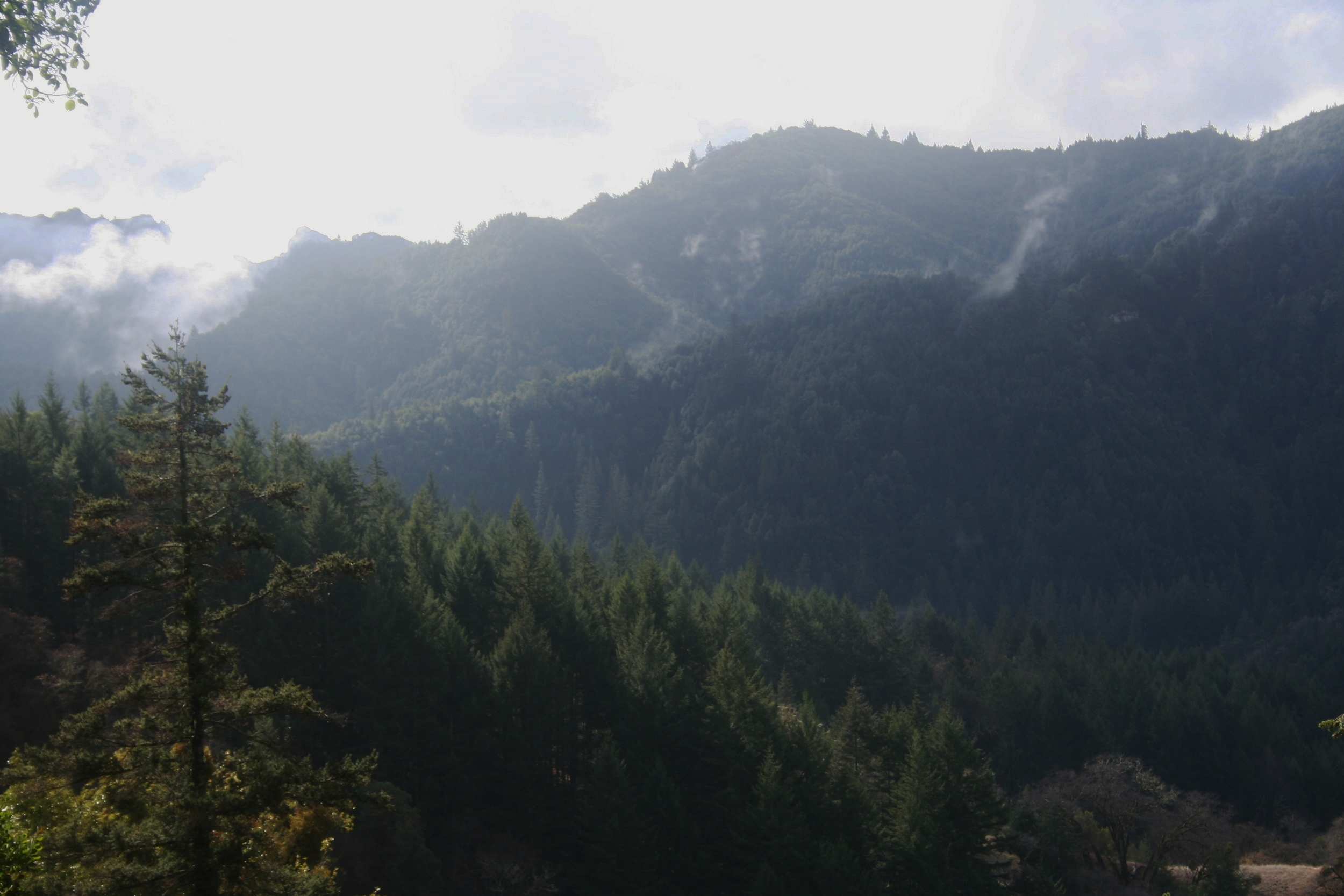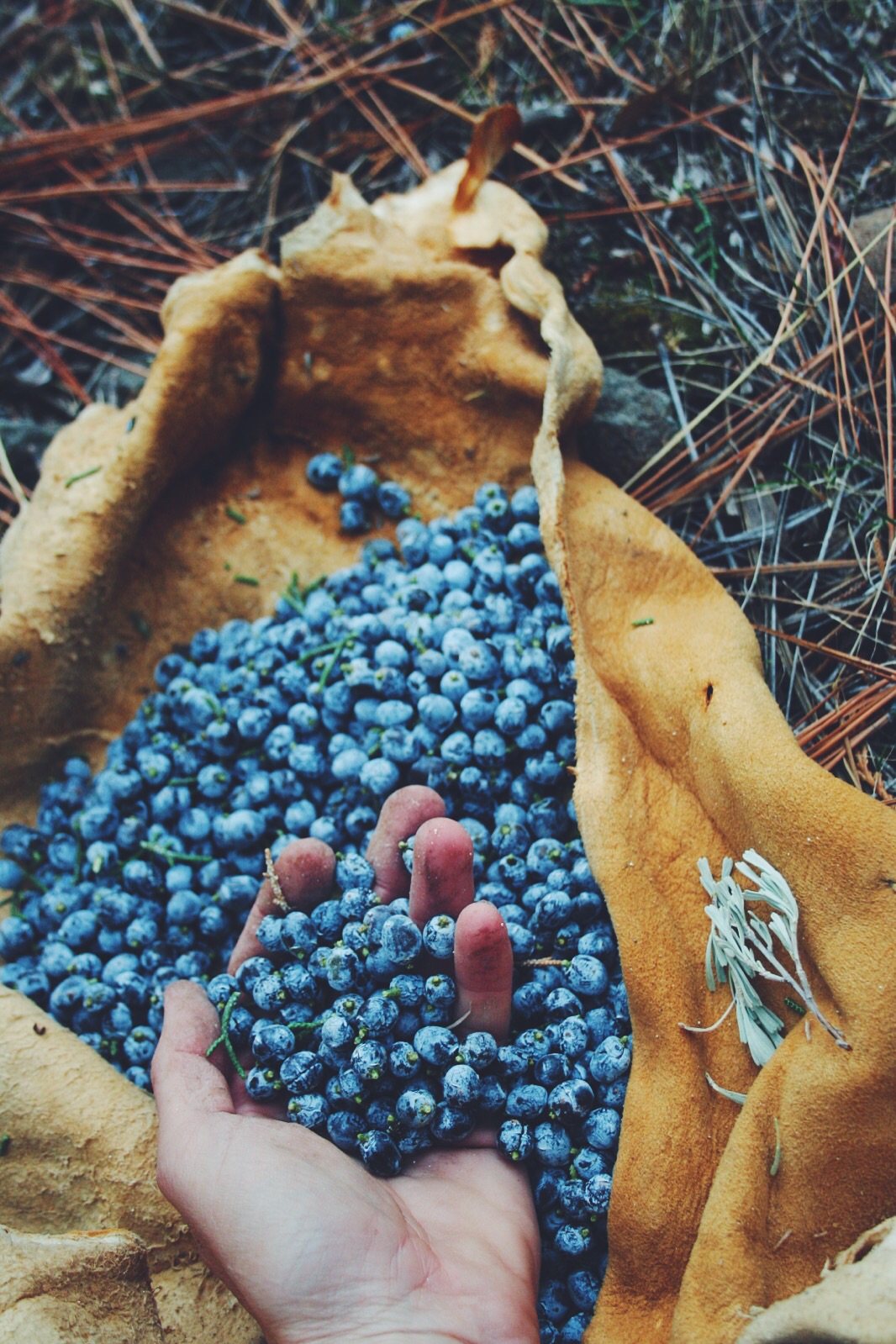Since I started traveling and spending time out west, specifically all over California, I have become fascinated by this plant. Tanoak. Tanbark oak. It is a fascinating morphing tree/bush that mirrors many other plants in this state and on the West Coast that seem to grow in really specific places and change according to the drastically variable landscapes.
Coastal subspecies of Tanbark oak, Notholithocarpus densiflorus (Fagaceae)
The West. has diverse and differentiated climates and ecological zones, especially in California. The winter is dominated by lots of rain across the state, specifically more in Northern California or snow at high elevations in the Sierras or other mountain ranges in the north. The temperatures, even up in the high Sierras, are never quite as dramatic as what I've experienced living in New England. It doesn't seem to stay -6 for a week straight like it can in New Hampshire or Maine. This is my experience though, there's always exceptions. There's so much diversity in California that it would take many pages to untie each zone. But, you can travel from one hill to another, or north/south by 50 (or even 2) miles and encounter a totally different set of plants, animals, soil, even weather. The Sierras create a weather phenomena called the orographic effect. It's funny that I still remember that since taking an ecology class in high school, at a time when I had never actually experienced what this looks like because there are very few mountains right next to the ocean on the east coast of the U.S. When the weather comes in during the winter riding the ‘Pineapple’ Express, it crashed into several mountain chains in California, leaving mini rain shadows on the eastern sides of the chains. The biggest is the mountain chain that divides the eastern border of California from the Great Basin and Nevada, The Sierras.
Lake Tahoe in winter, High Sierras, CA.
These mountains catch a ton of snow that then melts until the summer for constant irrigation in the fertile Central Valley. The eastern side of the Sierras can catch snow, but traveling over the passes you notice immediately the change in ecology: from a mix of tall conifers to the Juniper/Piñon/Sagebrush that dominates the Great Basin. Immediately, you enter a zone that gets dramatically different amounts of rain each year. This is the orographic effect. The mountains catching and gathering the rain or fog on one side of the mountains leaving the other side much drier.
Coastal subspecies of Tanbark oak, Notholithocarpus densiflorus (Fagaceae)
So back to Tanbark Oak. It grows on the coast of California and in various spotty enclaves along the western slopes of the Sierra. What immediately drew me to it was the fact that it appeared to be an Oak or a Chestnut, yet it didn't lose its leaves in the fall. Its leaves didn't even seem to turn colors. The leaves seemed tough and hearty. There are Live Oak species that don't lose their leaves in California, but this tree seemed different.
Several years ago, I started bark or vegetable tanning deer hides. This is making leather naturally out of plant matter that contains tannins. I encountered this tree when I needed tannins, and wasn't as familiar with the species to use out West like I had become familiar with out East where I am from. Of course, I thought it was a good idea to travel and live out of my car with a sloshy bucket containing a smelly half tanned deer hide started on Sumac and Carolina Hemlock. I couldn't bear to let go of land based craft while also satisfying my need to travel and see and move into other landscapes. Sometimes this works and sometimes it doesn't. Somehow in this scenario, it worked. I started to gain a relationship with Tanbark because it played a role in an alchemical process for me that allowed an experience that is more intimate than just seeing it while walking through the woods.
Inland subspecies of Tanback Oak, Notholithocarpus densiflorus var. echinoides (Fagaceae) The undersides of the leaves have scurfy hairs.
Tan Oak and Chestnut leaf comparison.
Tan Bark oak is not really an Oak. Well, it's in the Fagaceae family, shared by Oaks, but also by Chestnuts, Chinquapin and Beech. To be an official Oak, a tree in the Fagaceae family must be in the Quercus genus, which is defined by certain common characteristics morphologically and genetically. Tan oak is not. When I first noticed it, the Chestnut bell went off in my head from seeing Chestnut scattered around the southern Appalachias. It's leaves, at least when it grows on the coast, resemble Chestnut leaves more than any Oak I've seen. It has the toothed margin, elongated leaf and similar venation. But it has 'acorns.' These acorns have a much tougher shell and more tannins than most Oaks. Thus the usefulness of the plant for tanning leather. So, my Oak bell went off too. It has a spiky acorn cup, which ring my Oak/Chinquapin/Chestnut bells all at once. What is up with this tree, I thought? Where does it fit in my mental plant map, gathered together by related plant characteristics?
California has so much literature on its diversity of plant species, including popular books like "Oaks of California" published by Cachuma Press. Surprisingly though, this book has only a small excerpt in it about Tan Oak. I suppose this is because it isn't an official Oak.
It's genus is Lithocarpus, the only member in North America. Its cousins, which include over 250 different species of Lithocarpus, are found in various parts of Asia. Although recent research, (cited at the end) shows that it is different enough from those other Lithocarpus in Asia because of so much time of being separated that it is now in its own super special genus: Notholithocarpus. It seems to share more characteristics with Quercus (Oak) and Chrysolepis (Chinquapin) than we formerly thought according to the research, and its pollen is unique; the dry details of which I won't go into unless you want to read the research yourself. California, like I mentioned at the beginning, is ripe for creating endemic species because of its rich geographic diversity.
Inland subspecies of Tanback Oak, Notholithocarpus densiflorus var. echinoides (Fagaceae) Interesting to note how they do lose their leaves: with the green ones still attached and growing.
I have spent time using and observing the plant on the coast and on the western slopes of the Sierras. On the coast, I have seen it mixed into the dark Douglas Fir, Big-leaf Maple, Western Hemlock, & Huckleberry dominated forests.
Friends Loren and Pierce in a Douglas Fir tree, in a Douglas Fir / Tanoak forest.
Coast Range
Hiking around in different locations in the foothills of the Sierras, I notice the tree's leaves taking on so many different shapes and sizes. This could be due to soil and light variability. This is not uncommon for Oaks in California, especially Live Oak species. Out east, most of our Oaks lose their leaves until you head closer to the coast where Live Oak species thrive in the milder climate. Both the Live Oaks and Tan Oak don't lose their leaves probably because it is an adaptation to California's predominantly Mediterranean climate (of course, again, it is so variable according to geography). The climate is generally mild, with long periods of dryness in the summer. Keeping their leaves allows them to hold onto more water, and because of the winter not being as cold, it doesn't harm the tree to keep on photosynthesizing. Some wild trees like the Oracle Oak, a hybrid between Interior Live Oak which keeps its leaves and Black Oak which doesn't, loses its leaves some years when the winters are harsher and keeps its leaves other years.
Ed in Pygmy Pine forest
As I mentioned before, there are populations of Tan Oak on the coast and inland. At first, I didn't trust that the ones I was seeing inland were even the same tree. They tend to be smaller, have smaller leaves most of the time, sometimes barely serrated. But, they still are evergreen, and still have those famously spiky caps. The tannins of Tan Oak smelled and tasted similarly to what I harvested from downed trees or stump sprouts on the coast. After talking to a botanist friend in the foothills, he insisted that it was indeed the same tree. Going on mushroom forays in the Sierra foothills, mycologists rave about mushrooms specific to the Tan Oak canopy. Apparently these two subsets are different enough, and to make things even more complex, they are split into different subspecies, the foothills and inland incarnation now being called Notholithocarpus densiflorus var. echinoides. I see this a lot in California, like with the Pygmy Pine on the Mendocino coast, really a subspecies of Lodgepole (Pinus contorta subsp. bolanderi), a tree and plant community that is fit for a whole different discussion.
Chestnut leaf. I am unsure if it is an American Chestnut or some kind of Asian variety given it was planted during mining days and is not leafed out, thus I cannot properly key it out.
I've been able to watch it grow next to an old grove of full grown Chestnut trees I found in the forest planted by gold miners back during mining times in the Sierra foothills. Some of these Chestnuts are in decline but not in the same way you see them out east. The American Chestnut used to be a dominant tree in the eastern forests, but because of the Chestnut blight, is not any longer. You only find it up at high elevations sprouting back from old stumps, or in the yard of an old homestead holding out as long as it can. The trees out west are isolated populations due to being planted out of their native range, or are Chinese Chestnuts, which are generally immune or less affected by the Chestnut blight. Its neat to see a whole forest floor full of spiky chestnut remnants, showing me what the Appalachian forest floor must have looked like when Chestnut was the dominant tree.
Chestnut, Castanea sp. (Fagaceae) spikey burrs scattered over an acre of forest that once was a planted and tended grove. Chinquapin also makes these burrs, but are smaller in size.
The ethnobotanical literature suggests that the acorns of this tree were preferred by native peoples who relied heavily on acorns for food regionally. It is said that they were preferred due to their high tannin content and stored longer. That high tannin content is great for making leather, but makes for more work when processing acorns for food. When processing acorns, you leach out the tannins to make the acorns digestible and palatable. There are a number of ways to do this, and every tribe had a slightly different take or technique. Each species of Oak (or sort of Oak in this case) has varying levels of tannins in its bark, leaves and nuts.
Tanbark cup and acorns.
Spikey cups, spent leaves and an acorn of inland subspecies of Tanback Oak Notholithocarpus densiflorus var. echinoides (Fagaceae)
The leather I made from Tan Oak sprouts and bark turned out really well. The first piece of leather I made using the tree took me six months, mostly because I was traveling around and couldn't be on it all the time. With all the neglect, it turned out surprisingly well, being about 85% Tan Oak tannins. I was told though, that crossing the tannin profiles with different species is a good thing to do to make strong leather. And, taking longer to tan it, as long as it is past a certain point may make stronger leather. There are different theories and studies on tannin quality variability in leather in relationship to time taken to tan, which tannins used, dried tannins versus fresh, or powdered bark vs unpowdered. I don’t know 'the right way’ per se, but I just experiment.
Eric pouring fresh tannins into a bucket with deer hides nearly done tanning.
A 5 gallon bucket for 2 deer hides is not ideal because it makes it so that the hides have less room to move and be tanned evenly. If they are tanned for a longer time and moved and skudded often, it can still work out okay.
A vegetable/bark tanning hide in process. You can see some streaks and discoloration due to the hide not being stirred enough.
You can see the 'grain' of the hide puckering from the pickling effect of the tannin baths. The tannins penetrate the hide and tighten the fiber layer, increasing the waterproofness of the skins. The liquid can move in and out but the tannins do not escape once penetrated.
Eric stirring the hides.
Not a super strong brew of tannins, but color can sometimes be deceiving when trying to gauge tannin content. Taste is a good measure.
I am no expert on bark tanning, nor am I on plants, but here I lay observations and engagements with this plant, Tan Oak and a process I have engaged using it. The process has given me information and feelings that I wouldn't have otherwise just seeing the tree in the forest. Of course, the more you engage anything, the more you learn about it. So, I welcome shifts and incremental changes that observations, study, engagement and sensory experience can muster.
From left to right: smoked brain tanned buckskin, Coffee/Tea/Tanoak tanned leather, Hemlock/Sumac/Tanoak Tanned leather, brain tanned sheepskins.
'skudding'
Works Cited:
Manos, Paul. Cannon, Charles. Oh, Sang-Hun. PHYLOGENETIC RELATIONSHIPS AND TAXONOMIC STATUS OF THE PALEOENDEMIC FAGACEAE OF WESTERN NORTH AMERICA: RECOGNITION OF A NEW GENUS, NOTHOLITHOCARPUS. Madrono. Vol. 55, No. 3, pp. 181–190, 2008. California Botanical Society. http://www.bioone.org/doi/abs/10.3120/0024-9637-55.3.181
Pavlick, Bruce M. Oaks of California. Los Olivos, Ca: Cachuma Press, 1991. Print.





























































